A) no change from the above, as fresh water is its native environment
B) lysis
C) plasmolysis
D) slight shrinkage
Correct Answer

verified
Correct Answer
verified
Multiple Choice
The most recently discovered phylum in the animal kingdom (1995) is the phylum Cycliophora. It includes three species of tiny organisms that live in large numbers on the outsides of the mouthparts and appendages of lobsters. The feeding stage permanently attaches to the lobster via an adhesive disk, and collects scraps of food from its host's feeding by capturing the scraps in a current created by a ring of cilia. The body is sac-like and has a U-shaped intestine that brings the anus close to the mouth. Cycliophorans are eucoelomate, do not molt (though their host does) , and their embryos undergo spiral cleavage. -Which of these features is least useful in assigning the phylum Cycliophora to a clade of animals?
A) having a true coelom as a body cavity
B) having a body symmetry that permits a U-shaped intestine
C) having embryos with spiral cleavage
D) lacking ecdysis (molting)
Correct Answer

verified
Correct Answer
verified
Multiple Choice
The most recently discovered phylum in the animal kingdom (1995) is the phylum Cycliophora. It includes three species of tiny organisms that live in large numbers on the outsides of the mouthparts and appendages of lobsters. The feeding stage permanently attaches to the lobster via an adhesive disk, and collects scraps of food from its host's feeding by capturing the scraps in a current created by a ring of cilia. The body is sac-like and has a U-shaped intestine that brings the anus close to the mouth. Cycliophorans are eucoelomate, do not molt (though their host does) , and their embryos undergo spiral cleavage. -Basing your inferences on information in the previous paragraph, to which clade(s) should cycliophorans belong? 1) Eumetazoa 2) Deuterostomia 3) Bilateria 4) Ecdysozoa 5) Lophotrochozoa
A) 1 only
B) 1 and 3
C) 1, 3, and 5
D) 2, 3, and 4
E) 2, 3, and 5
Correct Answer

verified
Correct Answer
verified
Multiple Choice
The most recently discovered phylum in the animal kingdom (1995) is the phylum Cycliophora. It includes three species of tiny organisms that live in large numbers on the outsides of the mouthparts and appendages of lobsters. The feeding stage permanently attaches to the lobster via an adhesive disk, and collects scraps of food from its host's feeding by capturing the scraps in a current created by a ring of cilia. The body is sac-like and has a U-shaped intestine that brings the anus close to the mouth. Cycliophorans are eucoelomate, do not molt (though their host does) , and their embryos undergo spiral cleavage. -On the basis of the cleavage pattern of cycliophoran embryos, which of these should be true?
A) It has determinate development.
B) The blastopore becomes the anus.
C) They are deuterostomes.
D) A cell separated from a four-cell embryo should develop into a complete organism.
Correct Answer

verified
Correct Answer
verified
Multiple Choice
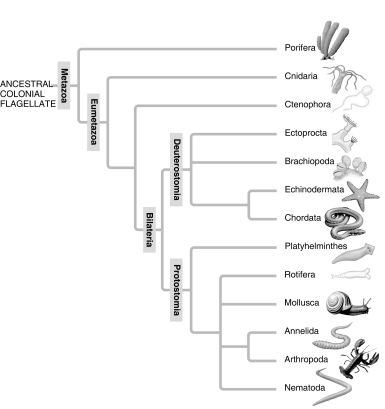 A: Morphological phylogeny.
A: Morphological phylogeny.
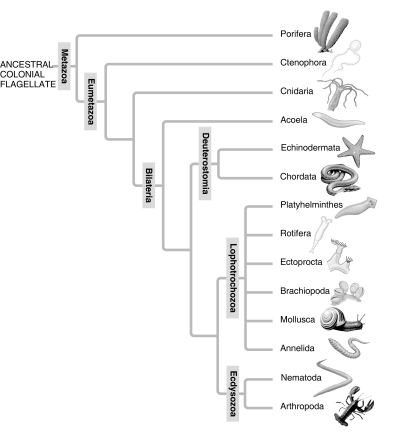 B: Molecular phylogeny.
-According to the phylogenies depicted in the previous pair of figures, if one were to create a taxon called Radiata that included all animal species whose members have true radial symmetry, then such a taxon would be
B: Molecular phylogeny.
-According to the phylogenies depicted in the previous pair of figures, if one were to create a taxon called Radiata that included all animal species whose members have true radial symmetry, then such a taxon would be
A) paraphyletic.
B) polyphyletic.
C) monophyletic.
D) a clade.
E) More than one of these responses are correct.
Correct Answer

verified
Correct Answer
verified
Multiple Choice
Table 32.1. Proposed Number of Hox Genes in Various Extant and Extinct Animals
 -Two competing hypotheses to account for the increase in the number of Hox genes from the last common ancestor of bilaterians to the last common ancestor of insects and vertebrates are: (1) a single duplication of the entire four-gene cluster, followed by the loss of one gene, and (2) three independent duplications of individual Hox genes. To prefer the first hypothesis on the basis of parsimony requires the assumption that
-Two competing hypotheses to account for the increase in the number of Hox genes from the last common ancestor of bilaterians to the last common ancestor of insects and vertebrates are: (1) a single duplication of the entire four-gene cluster, followed by the loss of one gene, and (2) three independent duplications of individual Hox genes. To prefer the first hypothesis on the basis of parsimony requires the assumption that
A) the duplication of a cluster of four Hox genes is equally likely as the duplication of a single Hox gene.
B) there is an actual process by which individual genes can be duplicated.
C) genes can exist is spatial groupings called clusters.
D) clusters of genes can undergo disruption, with individual genes moving to different chromosomes during evolution.
Correct Answer

verified
Correct Answer
verified
Multiple Choice
Which of the following characteristics generally applies to protostome development?
A) radial cleavage
B) determinate cleavage
C) diploblastic embryo
D) blastopore becomes the anus
E) archenteron absent
Correct Answer

verified
Correct Answer
verified
Multiple Choice
The most recently discovered phylum in the animal kingdom (1995) is the phylum Cycliophora. It includes three species of tiny organisms that live in large numbers on the outsides of the mouthparts and appendages of lobsters. The feeding stage permanently attaches to the lobster via an adhesive disk, and collects scraps of food from its host's feeding by capturing the scraps in a current created by a ring of cilia. The body is sac-like and has a U-shaped intestine that brings the anus close to the mouth. Cycliophorans are eucoelomate, do not molt (though their host does) , and their embryos undergo spiral cleavage. -Using similarities in embryonic development, body symmetry, and other anatomical features to assign an organism to a clade involves 1) cladistics based on body plan. 2) molecular-based phylogeny. 3) morphology-based phylogeny.
A) 1 only
B) 2 only
C) 3 only
D) 1 and 2
E) 1 and 3
Correct Answer

verified
Correct Answer
verified
Multiple Choice
The distinction between sponges and other animal phyla is based mainly on the absence versus the presence of
A) a body cavity.
B) a complete digestive tract.
C) a circulatory system.
D) true tissues.
E) mesoderm.
Correct Answer

verified
Correct Answer
verified
Multiple Choice
With the current molecular-based phylogeny in mind, rank the following from most inclusive to least inclusive. 1) ecdysozoan 2) protostome 3) eumetazoan 4) triploblastic
A) 4, 2, 3, 1
B) 4, 3, 1, 2
C) 3, 4, 1, 2
D) 3, 4, 2, 1
E) 4, 3, 2, 1
Correct Answer

verified
Correct Answer
verified
Multiple Choice
Acoelomates are characterized by
A) the absence of a brain.
B) the absence of mesoderm.
C) deuterostome development.
D) a coelom that is not completely lined with mesoderm.
E) a solid body without a cavity surrounding internal organs.
Correct Answer

verified
Correct Answer
verified
Multiple Choice
Trichoplax adhaerens (Tp) is the only living species in the phylum Placozoa. Individuals are about 1 mm wide and only 27 μm high, are irregularly shaped, and consist of a total of about 2,000 cells, which are diploid (2n = 12) . There are four types of cells, none of which are nerve or muscle cells, and none of which have cell walls. They move using cilia, and any "edge" can lead. Tp feeds on marine microbes, mostly unicellular green algae, by crawling atop the algae and trapping it between its ventral surface and the substrate. Enzymes are then secreted onto the algae, and the resulting nutrients are absorbed. Tp sperm cells have never been observed, nor have embryos past the 64-cell (blastula) stage. -On the basis of information in the previous paragraph, which of these should be able to be observed in Tp?
A) the act of fertilization
B) the process of gastrulation
C) eggs
D) All three of the responses above are correct.
E) Two of the responses above are correct.
Correct Answer

verified
Correct Answer
verified
Multiple Choice
Placozoan evolutionary relationships to other animals are currently unclear, and different phylogenies can be created, depending on the character used to infer relatedness. Sponges have no tissues, but about 20 cell types. Tp (Trichoplax adhaerens) produces a neuropeptide almost identical to one found in cnidarians. The genome of Tp, though the smallest of any known animal, shares many features of complex eumetazoan (even human!) genomes. The next three questions refer to the phylogenetic trees that follow.
I. 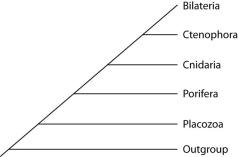 II.
II. 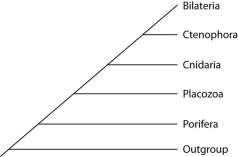 III.
III. 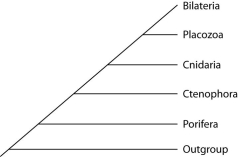 -Which phylogeny has been created by emphasizing the structural simplicity of placozoans?
-Which phylogeny has been created by emphasizing the structural simplicity of placozoans?
A) I
B) II
C) III
Correct Answer

verified
Correct Answer
verified
Multiple Choice
Table 32.1. Proposed Number of Hox Genes in Various Extant and Extinct Animals
 -All things being equal, which of these is the most parsimonious explanation for the change in the number of Hox genes from the last common ancestor of insects and vertebrates to ancestral vertebrates, as shown in the table?
-All things being equal, which of these is the most parsimonious explanation for the change in the number of Hox genes from the last common ancestor of insects and vertebrates to ancestral vertebrates, as shown in the table?
A) The occurrence of seven independent duplications of individual Hox genes.
B) The occurrence of two distinct duplications of the entire seven-gene cluster, followed by the loss of one cluster.
C) The occurrence of a single duplication of the entire seven-gene cluster.
Correct Answer

verified
Correct Answer
verified
Multiple Choice
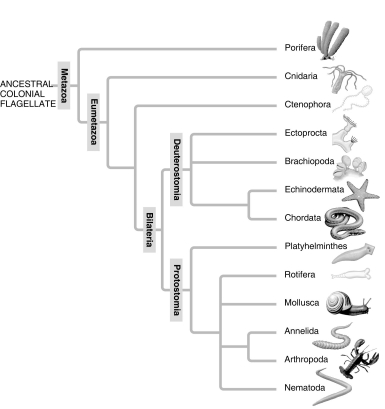
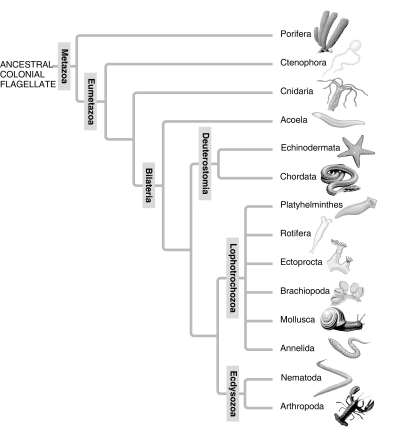 -Which of the following is a point of conflict between the phylogenetic analyses presented in these two figures?
-Which of the following is a point of conflict between the phylogenetic analyses presented in these two figures?
A) the monophyly of the animal kingdom
B) the relationship of taxa of segmented animals to taxa of nonsegmented animals
C) that sponges are basal animals
D) that chordates are deuterostomes
E) the monophyly of the bilaterians
Correct Answer

verified
Correct Answer
verified
Multiple Choice
The most recently discovered phylum in the animal kingdom (1995) is the phylum Cycliophora. It includes three species of tiny organisms that live in large numbers on the outsides of the mouthparts and appendages of lobsters. The feeding stage permanently attaches to the lobster via an adhesive disk, and collects scraps of food from its host's feeding by capturing the scraps in a current created by a ring of cilia. The body is sac-like and has a U-shaped intestine that brings the anus close to the mouth. Cycliophorans are eucoelomate, do not molt (though their host does) , and their embryos undergo spiral cleavage. -Which of these, if discovered among cycliophorans, would cause the most confusion concerning our current understanding of cycliophoran taxonomy?
A) if the ciliated feeding ring is a lophophore
B) if embryos are diploblastic
C) if the body cavity is actually a pseudocoelom
D) if the organisms show little apparent cephalization
Correct Answer

verified
Correct Answer
verified
Multiple Choice
An adult animal that possesses bilateral symmetry is most certainly also
A) triploblastic.
B) a deuterostome.
C) eucoelomate.
D) highly cephalized.
Correct Answer

verified
Correct Answer
verified
Multiple Choice
The larvae of some insects are merely small versions of the adult, whereas the larvae of other insects look completely different from adults, eat different foods, and may live in different habitats. Which of the following most directly favors the evolution of the latter, more radical, kind of metamorphosis?
A) natural selection of sexually immature forms of insects
B) changes in the homeobox genes governing early development
C) the evolution of meiosis
D) the development of an oxidizing atmosphere on Earth
E) the origin of a brain
Correct Answer

verified
Correct Answer
verified
Multiple Choice
The blastopore denotes the presence of an endoderm-lined cavity in the developing embryo, a cavity that is known as the
A) archenteron.
B) blastula.
C) coelom.
D) germ layer.
E) blastocoel.
Correct Answer

verified
Correct Answer
verified
Multiple Choice
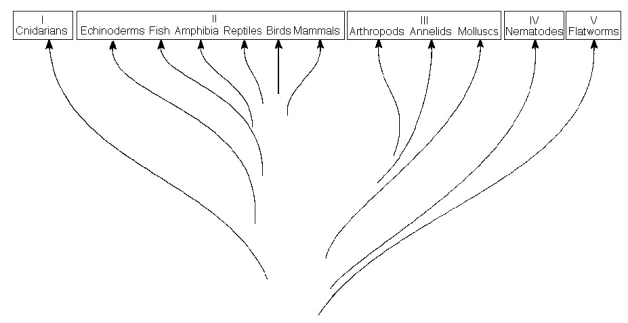 The previous figure shows a chart of the animal kingdom set up as a modified phylogenetic tree. Use the diagram to answer the following questions.
-Which two groups are most clearly represented in the Ediacaran fauna?
The previous figure shows a chart of the animal kingdom set up as a modified phylogenetic tree. Use the diagram to answer the following questions.
-Which two groups are most clearly represented in the Ediacaran fauna?
A) I and II
B) I and III
C) II and IV
D) II and V
E) IV and V
Correct Answer

verified
Correct Answer
verified
Showing 41 - 60 of 74
Related Exams